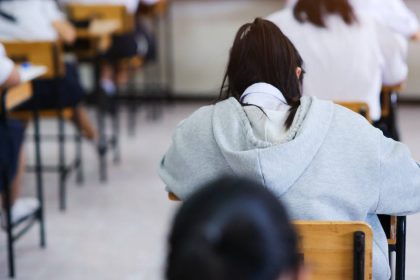Public secondary students are skipping more school than ever recorded in Victoria, with absenteeism levels well above pre-COVID levels as school refusal rates contribute to online learning enrolments surging.
Students enrolled in state secondary schools missed an average of 5.6 weeks in Victoria in 2023 – up from 3.5 weeks in 2018.
Experts say the rising rates of chronic absence and school refusal are disproportionately impacting disadvantaged families, with a federal inquiry calling for a national plan to combat the problem.
At the Australian National University, demographer Liz Allen says post-pandemic burnout – compounded by complex health concerns among students – is affecting both teachers and families as the rates of school absenteeism continue to cause concern.
Allen says familial disadvantage is a key driver, with the high cost of sending children to school seeing some families keeping kids because they simply can’t afford to send them to school.
After exploring school absenteeism more broadly, Allen says priorities were reassessed within families during the challenging years of COVID-19 lockdowns and the result was changed work habits that enabled more people to keep kids out of school when they were unwell.
Allen says “we’ve not socially recovered from COVID lockdowns”.
“School and education disruptions have had an impact on our lives that we haven’t quite been able to understand.”
Although she says it would be “very easy to blame students and their families and to suggest what we’re seeing is truancy”, the truth is more nuanced and complex.
“This is a social issue …we’re seeing it across the world,” she says, adding that the important question is “what are we going to do about it?”
School absenteeism is most pronounced within year nine student cohorts, with data from the Victorian Department of Education revealing state school students at Victorian high schools missed an average of 6.5 weeks in 2023, up from 4.6 weeks in 2018.
Although attendance at the state’s primary schools improved in 2023 school absenteeism is still well above pre-COVID levels.
Enrolments at Victorian primary schools show students skipped an average of 4.1 weeks in 2023. It’s a figure that is down from 4.6 in 2022, but above the 3.1-week average in 2018.
But as attendance declines at traditional schools across the state, Virtual School Victoria has enrolment figures trend upwards over the last decade, with students citing social and medical reasons for the shift away from real-world schools.
In 2023, school refusal led to health professionals referring 1072 students to Virtual School Victoria – up from 386 in 2018.
In its submission to the senate inquiry, Virtual School Victoria offered an insight into the impact of unchecked school refusal, saying that, as school attendance decreases, students often experience a breakdown of peer relationships.
“The increasing impact of social anxiety and depression spiral together with this to compound social isolation, leaving many of our students struggling to leave their home, or in some cases, even their bedroom.
“Relationships between students and parents/carers and siblings deteriorate under the pressure of living and learning at home, with reports of ongoing conflict escalating to aggressive outbursts from students, violence within the home and acute mental health concerns including self-harm and suicide risk.”
But a Victorian Education Department spokesperson said data collected from government schools through daily attendance and absence recording suggested that school refusal accounted for just two per cent of all absences in 2023, with other reasons including overseas travel with family, medical appointments and illness.
“Victoria’s student attendance rates continue to lead the nation – in 2023 Victorian students again had the best attendance of any state or territory.”
The Victorian government acknowledged that “school refusal may be reported as other types of absence” in its submission to the federal inquiry. “Although the prevalence of school refusal as a reason given for student absence is low, it does show an increase across all years from 2018 to 2021,” its submission stated.
“The data available suggests that school refusal is more prevalent in secondary and specialist schools than primary schools and in more disadvantaged schools and those in rural and regional areas.”
In 2023, school absenteeism in Victoria was more pronounced in regional areas, with public school students in the Central Goldfields LGA, encompassing the towns of Maryborough, Castlemaine and Talbot, recording the most absences.
Students in Stonnington, Monash and Boroondara – all in Melbourne’s east and south-eastern suburbs – had the highest attendance rates at the state’s public schools.
From Allen’s perspective, though, blaming student absenteeism on families taking holidays during the school term only masks the bigger issue.
“If we look at the data, kids from low socio-economic backgrounds are most impacted,” the demographer says.
“So, we can say with great confidence that a great deal of school absenteeism is likely to do them a disadvantage, and that to me is incredibly sobering. Education is the passport to life.”







